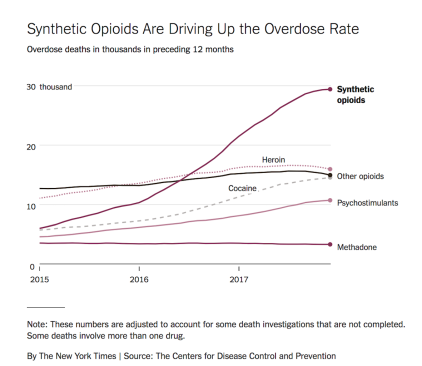The dots connect.
Building. Physical injury. Pain. Treatment. Addiction.
Other dots connect.
Among professions and occupations, construction is one of the five top ranked fields for addictions, ranking 2nd to mining for rates of heavy alcohol consumption, 4th in rates of illicit drug use, and 2nd in percentage of associates who report suffering from substance use disorders.
Now this. The death toll from drug overdoses–72,000 in 2017, according to preliminary estimates of the Centers for Disease Control–exceeds the number of annual fatalities related to H.I.V., car crashes, or shootings.
How many of those 72,000 deaths directly related to people whose livelihoods were in the residential construction building and business community? How many of the hundreds of thousands–maybe–of still active users and abusers of opioids for pain, or for the pain of addiction, are part of the labor and talent pool you hear talked about as one of construction’s biggest challenges right now? As many as 20 million Americans yearly say that recurrent alcohol or illicit drug use cause them clinically significant impairment, including health problems, disability, and failure to meet major responsibilities at work, school, or home.
How many are construction laborers, job site supervisors, office associates, Wall Street and data analysts, architects, engineers, people we see and deal with and depend on every day to make home building and their partner organizations work and generate value?
The dots all connect, and they make a persuasive case that the problem is everywhere and therefore must be here, but does anyone know? What we do know–tragically–is someone, or at the very least, someone who knows someone, who’s become a casualty of our national opioid epidemic, a statistic.
New York Times staffer Margot Sanger-Katz reports that the second of two reasons for the deadly trend may be even more important than the first: one, opioid use–and abuse–is increasing, and two, the drugs people are gaining access to are more mortally dangerous than ever.

Strong synthetic opioids like fentanyl and its analogues have become mixed into black-market supplies of heroin, cocaine, methamphetamine and the class of anti-anxiety medicines known as benzodiazepines. Unlike heroin, which is derived from poppy plants, fentanyl can be manufactured in a laboratory, and it is often easier to transport because it is more concentrated.
Unexpected combinations of those drugs can overwhelm even experienced drug users. In some places, the type of synthetic drugs mixed into heroin changes often, increasing the risk for users.
According to a 35-year-old, West Virginia-based builder–a recovering heroin addict–told us last summer: “Painkillers, he says, are easy to learn about on a jobsite because, in his experience, they’re widely used and sometimes abused.”
Now, this is anecdotal information, like so much data when it comes to matching up illegal and unsafe drug use and its impacts on home construction. Is anecdotal information enough to make a change?
Of course, one of the reasons the information is anecdotal has to do with the population of many of the workers–including the 25 or more construction trades–and their current status as workers in America. They don’t want to–or can’t risk to–be counted. They’re hourly, off-the-books, off-the-radar human beings whose work means something in terms of construction cycle time, deadlines, and delivery dates, but whose lives may matter less.
At any rate, as powerful as anecdotal stories can be–instances of the widening gyre of tragic impact the opioid epidemic has on our current and future working associates’ lives, there’s a commonly held law of business, “You can only manage what you measure,” that applies here.
And this is the action builders, partners, members of the residential investment, development, design, engineering, and construction communities can take. Start counting. Clock people in who need treatment, who need help, who need to be recognized as having a problem that can spread, not only farther into that individual’s life, but across into other lives, each with a network of collaterally connected lives.
This is how epidemics get worse–no one takes a full measure of them, how they work, how contagious they are, what causes them, and worst of all, how they can hide in plain sight. If you see something, say something, and … do something. Count somebody who’s in pain as a human being who may need medical–drug addiction recovery–treatment.



